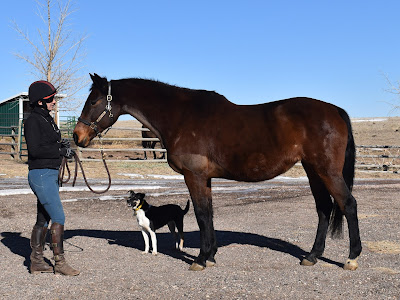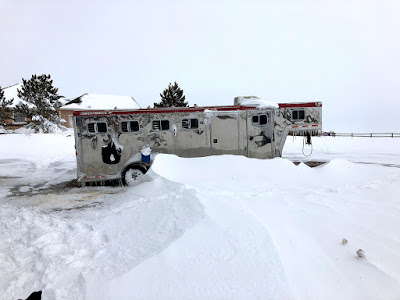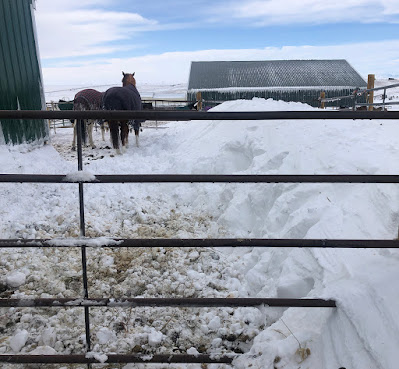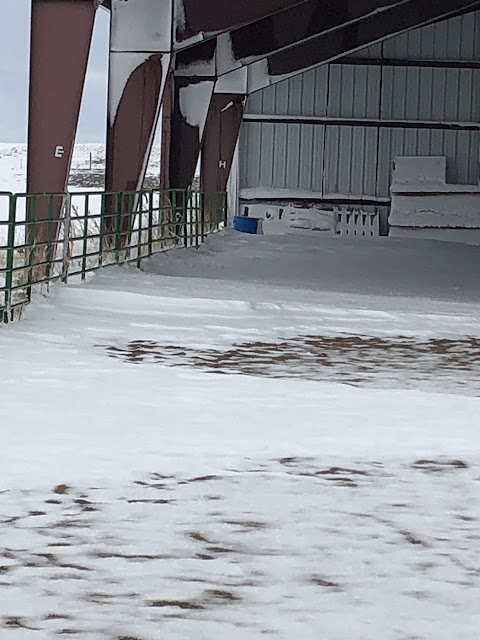I recently came across an article written by a very famous showjumper. The article appeared to be instructional with exercises to help a rider achieve a still and effective lower leg when jumping. Once I read it, however, I was sort of disappointed. It definitely emphasized the importance of having a secure lower leg over fences and correct angles in your leg joints, but didn't tell you HOW to get a secure leg or WHY those angles are important. Additionally it felt a bit like a product placement ad for his sponsor's stirrups.
I do understand it's important and necessary for sponsored riders to publicly recognize their backers - that is often the only way one can afford to compete for a living. However, I was hoping for a more thorough analysis of the hows and whys of leg position when jumping. Since I left the article feeling as though I was promised a root beer float but only allowed to eat the foam, I decided I'd rewrite the article the way I would have wanted the information to be presented.
Achieving a Still and Effective Lower Leg
In riding, regardless of discipline, the lower leg is an important part of a rider's equitation for several reasons. Because gravity is the rule on planet Earth, and the lower leg is the bottom most part of the body, the foot is like the anchor. With jumping photos, I will often "erase" the horse, and determine whether the rider could still stand upright on the ground without an equine beneath them. If the answer is yes, the lower leg is in the right place. When in the saddle, stirrups are "the ground" and should be directly beneath the rider for stability. Riders also have a bundle of nerves in the foot located approximately by the base of your big toe ball (this can vary slightly from person to person) which gives you information about where the ground/stirrup/your foot is and whether you can use it as a base of support.
If the brain is insufficiently aware of where the foot is in space (called proprioception for all the geeks out there), we see all kinds of issues like pinching with the knee (which makes the lower leg swing backwards over the jump and forwards on the flat), throwing the upper body forward or "jumping ahead of the horse", and losing stirrups. This leads us to the question: How do you get your body to pay attention to where your foot is?
Often as adults we have patterns of movement in our bodies that make it difficult to place our lower leg where it ought to be. If I sit in a chair all day at a desk, when I get into the saddle my body will want to put my leg out in front of me to recreate the "normal" sensation of being in a chair. There are many ways to approach changing this. One way is to tap on the bottom of your foot before you ride. Before getting on, if you sit on the mounting block and take a few moments to tap on the bottom of your foot with a braced finger or flat palm, you can effectively "wake up" the nerve bundle there by applying this physical stimulus. After the tapping, get into the saddle and take a moment to place your stirrup under the nerve bundle in your foot, so that you are really aware of the stirrup. Then go for a walk a few times around the arena, just noticing your feet.
Often riders will say that their foot feels heavier, or that the stirrup feels more pronounced, or that the stirrup leathers are too short. The sensations vary, but most of the time the rider does have a better feeling of where their foot is in space because the brain is now more aware of the foot through that nerve bundle.
The Ankle, Knee, and Hip
The joints of the leg are the rider's shock absorbers. That means ankles, knees, and hips all must be moving in order to save strain on the lower back, neck, and shoulders. An exercise to check that your shock absorbers are working can again be done at the mounting block before you get on. Stand on the bottom step of the block, and with both feet at the same time, gently hop off the block onto the ground.
Notice how you landed, were you tipped forwards with weight in your toes? Did your knees bend on landing or stay braced? Did your hip angle close when your feet touched the ground, sending your butt backwards and your head forwards? If you have sand in your riding area perhaps step out of your landing footprints and notice what parts of your feet made the deepest impression. Climb back up on the lowest step and hop off again. Did anything change? Repeat this several times until you feel you're landing in the middle of your foot, and all your shock absorbers, ankles, knees, hips, are moving sufficiently to absorb the impact.
The Ankle
I have several different exercises specific to the ankle. While mounted, take your feet out of the stirrups. Draw imaginary circles with your feet, to get your ankles moving. Then wiggle your toes inside your boots, like you were playing the piano. Place your feet back in the stirrups, and make the circles again, keeping your foot in the stirrup. Play with lowering and lifting your heels, and notice what feels the most relaxed to you. Usually this is with the foot fairly level in the stirrup, to a slightly lower heel than toe. You don't want to brace up on your toes with your heel high for safety reasons, that position makes it easier to get your foot caught in the stirrup and no one wants to get dragged! However you don't want to brace with your heel shoved down, because then you don't have the mobility to absorb motion with your ankle.
This is a good place to talk about stirrups. What are the best kind of stirrups? The ones in which you are most comfortable. Some people like the plastic composite stirrups with a wide base as shown in the above photo, others prefer traditional metal irons with a narrow rubber pad as shown below. The horse industry has come up with an infinite number of combinations of features for stirrups, you can find everything from colors and safety release features to varying pads with different angles and types of grip. Some stirrups offset the hole at the top to change the angle at which the stirrup hangs relative to the saddle. Generally I've found that people with sore joints, either ankles, knees, or hips, are bracing and don't have sufficient mobility. Sometimes changing the style of stirrup will help the rider to relax and stop bracing, in which case that stirrup is the best one for that rider. Sometime all that's needed is to do some exercises to soften the joints and allow them to function as shock absorbers.
Knees can be tricky, and they can are incredibly important. They must be mobile to fulfill their shock absorbing mission, and they work best when not clamped to the saddle. If a rider pinches the saddle with their knees, it creates a pivot point that will nearly always toss a rider forwards over the horse's neck and have the lower leg swing backwards when jumping. To address this, I will often tell riders to point their toes away from the horse. This makes their knees pull away from the saddle, and transfers the weight back down into the lower leg rather than creating tension in the knee and inner thigh muscles. In some disciplines this is frowned upon as the toes are "supposed" to point forwards, but I'll get to that in a moment.
The Hip
Hips are often not where we expect them to be. When someone says to put your hands on your hips, you aren't actually putting your hands on your hip joints. To locate the actual joint, lift one leg and put your fingertips in front of your body into the crease that was created in the front of your pants. That's actually where the joint itself is located. So when you jump, you want to fold from there, not collapse at your belly. There is forwards/backwards motion in the hip joints, as well as rotation.
Getting back to the question of where one's toes should point, you can get your toes to point forwards without compromising ankle or knee mobility, by rotating your hips. If you place one hand under the back of your thigh, and lift that hamstring leg muscle away from your body, you'll find that your thigh bone (or femur for the geeks) rotates forwards, which then results in your toes pointing forwards. Voila'! Correct equitation without creating tension in the shock absorbers. A way to know if you've got it right is to look down the seam of your pants. The seam along your thigh should be perpendicular to the ground, like an arrow pointing down.
Putting It All Together
Most of these exercises can be done as part of your warmup, during your initial walk around the arena or as you begin your ride. It always surprises me how much more springy my horse is when I've taken the time to warm up my shock absorbers before asking my body (or the horse's body) do to something athletic.
Once you've played with some of these exercises which address specific joints, you can put the new way of riding to the test with some jumping exercises that will combine all the pieces. Something that you can practice to create a stable lower leg are gymnastics such as cavalletti, done in two point position. Can you stay in two point, keeping your shock absorbers loose, while going over a series of ground poles at the walk? Raised poles at the trot? Cantering over a series of bounces? Try changing what you focus on through the gymnastic. Think about landing in your feet after each jump, just like when you landed after hopping off the mounting block. Think about having bouncy ankles, or playing the piano with your toes, or pointing your knees away from the saddle. Which of these help you to feel more stable through the gymnastic? When you find a concept or visual that helps you, use it! Not all of the exercises will work for all people, but it's worth the energy investment to find something that is helpful to you.
These exercises, or some combination of them, should help you with creating a stable lower leg and better overall equitation. Why do they work? The answer is almost always, "Because the horse will do with his body whatever I do with mine". Humans and horses are made of the same parts, except that horses don't have a collar bone. If you are standing on the ground and bend at the waist, you are then in the same anatomical position as a horse on all fours.
If your leg joints are moving, your weight is shifted back in your seat, and you are sitting with your shoulders squared over your hips in the saddle, the horse will do the same. He will bend the joints of his hind legs (called engagement for the geeks out there), which makes his haunches lower causing him to shift his weight there, and then his front end will lift.
 With so many different things to consider, so many different exercises to try, and so many options in stirrups, no wonder a basic article about the lower leg in jumping may seem a bit superficial. Hopefully there is something within this in-depth article that you might try which could help your lower leg position. Remember that it's not essential to do everything, but to try something. And often the secret to good riding is not Try Harder, but Try Different.
With so many different things to consider, so many different exercises to try, and so many options in stirrups, no wonder a basic article about the lower leg in jumping may seem a bit superficial. Hopefully there is something within this in-depth article that you might try which could help your lower leg position. Remember that it's not essential to do everything, but to try something. And often the secret to good riding is not Try Harder, but Try Different.












































































